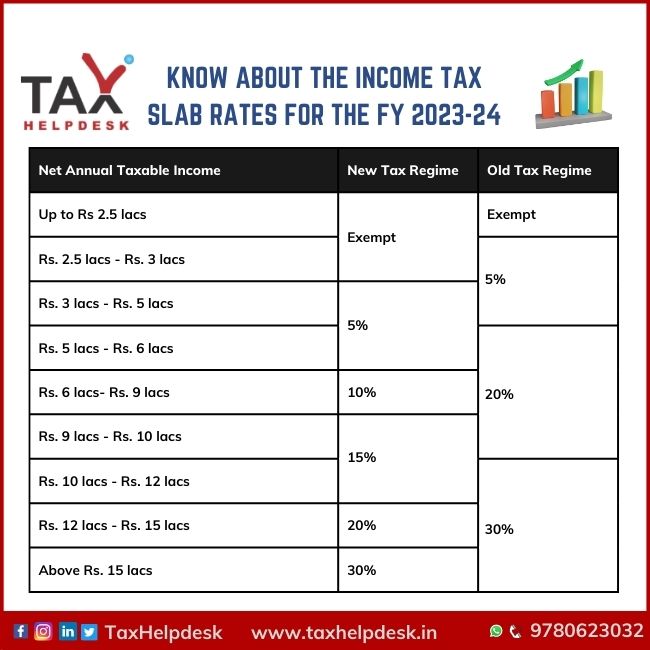The income tax slab for the Financial Year 2023-24 can help you understand how much tax you need to pay during the year. Having said that, just like every year, the income tax slab for Financial Year comprises different ranges of income with different rates. However, the government has introduced certain changes in Income Tax slabs for the Financial Year 2023-24.
In this blog, we will tell you about these changes as well as Income tax slabs for the FY 2023-24.
Income Tax Slab Changes
Through the Union Budget, 2023 many changes have been introduced in the income tax slab under the new tax regime for the FY 2023-24. In addition to this, there is also an increase in the exemption from Rs. 2.5 lacs to Rs. 3 lacs under the new tax regime. These changes are, however, not applicable to the old tax regime. This is to say that, slab rates under the old tax regime are as they were for the Financial Year 2022-23.
Also Read: Know About The Income Tax Slabs FY 2022-23 | FY 2021-22
Changes in the Income Tax Slab Rate under the New Tax Regime
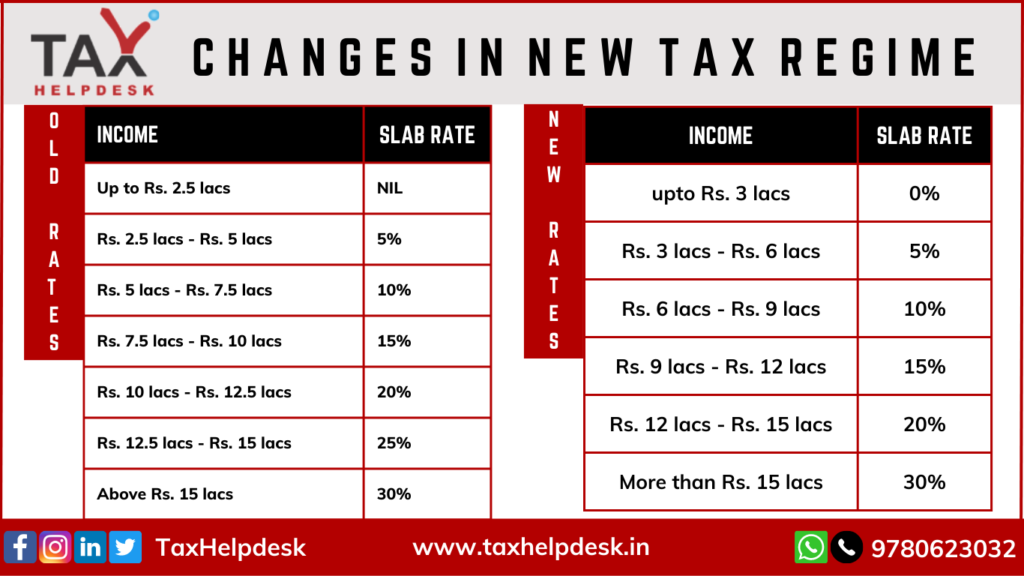
Also Read: Tax Rebate under the Old & New Tax Regime
Note:
Under the new tax regime, the income tax slab rates are the same for all age groups depending upon their income.
Income Tax Slab rates under the old tax regime
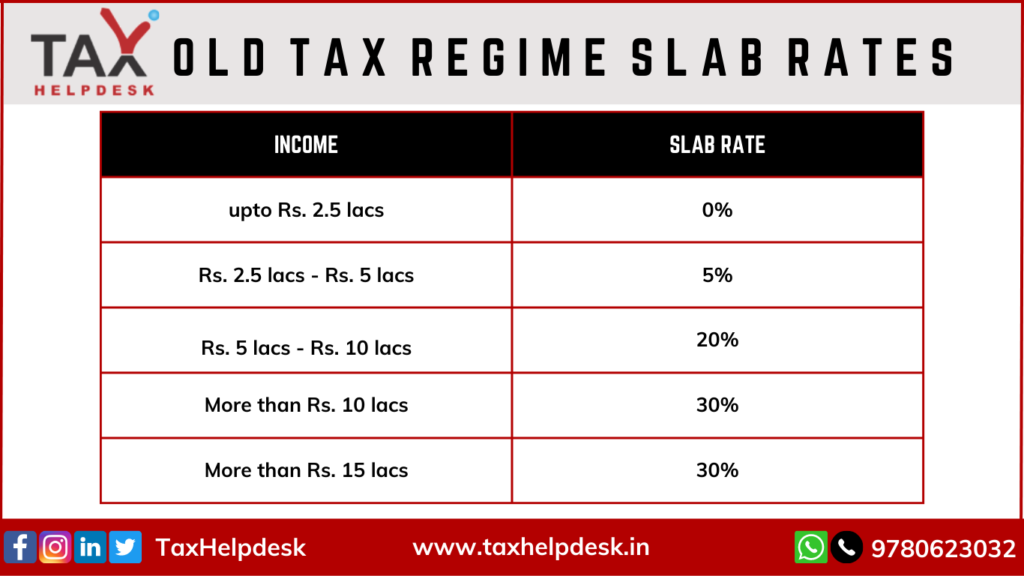
Key Differences Between Old & New Tax Regime
The new tax regime offers some relief to salaried individuals, senior citizens, HUFs, domestic companies, as well as cooperative societies in India. When comparing the old tax regime and the new tax regime, here are some things to note:
– The new tax regime offers six different new income tax slabs for individuals and HUFs in comparison to three in the old tax regime. These are as follows:
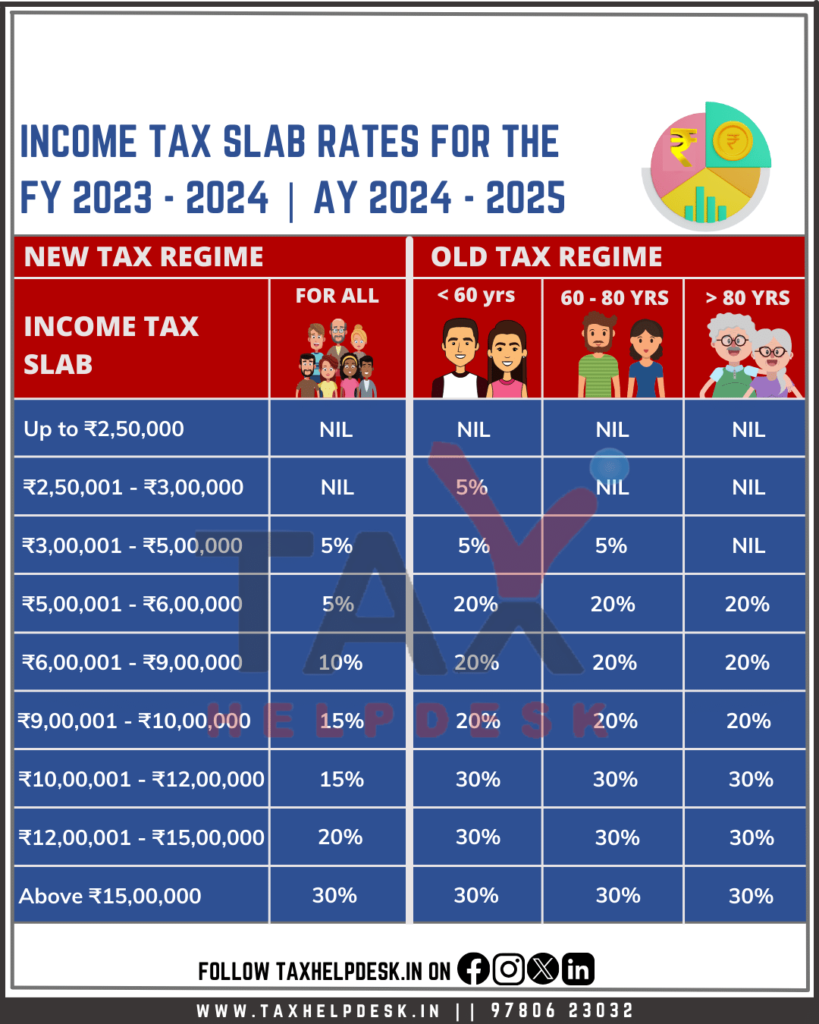
New Tax Regime has lower slab rates which helps in reducing income tax liability. However, the majority of exemptions, allowances, and deductions are not allow under this regime. These are as follows:
Particulars
New Tax Regime
(FY 2023-24)
House Rent Allowance Exemption
Not Allowed
Leave Travel Allowance Exemption
Not Allowed
Children Education Allowance
Not Allowed
Entertainment Allowance
Not Allowed
Other allowances including food allowance of Rs. 50/meal subject to 2 meals a day
Not Allowed
Interest available on home loan under Section 24b on self-occupied or vacant property
Not Allowed
Deduction under Section 80C (Investment in LIC, EPF, PPF, Tax Saving FD’s etc.)
Not Allowed
Employer’s contribution to NPS (Section 80CCD(2))
Not Allowed
Deduction on medical insurance premium under Section 80D
Not Allowed
Interest on education loan – deduction under Section 80E
Not Allowed
Interest on electrical vehicle – deduction under Section 80EEB
Not Allowed
Donation to political parties/trusts – deduction under Section 80G
Not Allowed
Deduction on Savings Bank Account under Section 80TTA/TTB
Not Allowed
Deductions to individuals with disability under Section 80U
Not Allowed
Other deductions
Not Allowed
However, some of the important deductions have been retained under the new tax regime which are as follows:
Allowances, Exemptions & Deductions Allowed Under The New Tax Regime
Limit/Amount
Voluntary Retirement Exemption
₹5,00,000
Gratuity Exemption
As per the formula.
Leave Encashment Exemption
The exemption is the least of the following:
– Actual leave encashment
– Cash equivalent of unutilized earned leave, subject to a maximum of 30 days for every year of completed service.
– Actual leave encashment received
Conveyance Allowance for travel between home and office
₹1,600/month
Perquisites for official purposes
No limit
Daily Allowance
No limit
Transport Allowance for specially-abled person
₹3,200/month
Gifts received from employers
₹5,000
Standard Deduction
₹50,000
Interest available on home loan under Section 24b on let-out property
Allowed as per the interest amount
Employer’s contribution to NPS (Section 80CCD(2))
14% of the employee’s salary (basic salary plus dearness allowance)
Contributions to Agniveer Corpus Fund – Section 80CCH
Entire amount that has been contributed
Also Read: Exemptions, Allowances, & Deductions under the Old & New Tax Regime
– Domestic companies have been given a concessional tax rate of 22% under section 115 BAA in the new tax regime versus 25% in the old regime as long as they do not claim exemptions or deductions such as:
| Deductions for units in special economic zones under section 10AA |
| Additional depreciation under Section 32 |
| Investment allowance under section 32AD for new plant and machinery made in notified backward areas |
| Deduction under Section 35 for expenditure on scientific research, or an amount paid to a university or research association or National Laboratory or IIT. |
| Deductions under Chapter VI-A allowed under section 80IA, 80IAB, 80IAC, 80IB |
– Manufacturing companies registered on or after March 1, 2016, and not claiming any exemptions or deductions, can choose to file taxes under section 115BA and pay 25% as opposed to 30%, as long as they do not claim deductions or exemptions.
– However, deduction under Section 80JJAA, for employment of new employees, has been retained so has deductions under Section 80M for dividends declared.
– Manufacturing companies that were registered on or after October 1, 2019, and have begun manufacturing on or before 31st March 2023 can pay a tax of 15% under Section 115BAB as per the new tax regime.
– Resident cooperative societies can choose to pay a reduced tax rate of 22% as per section 115BAD as long as they don’t claim deductions and exemptions. This is especially useful for societies with an income of more than ₹20,000 per annum.
Surcharge rates under the new and old tax regime
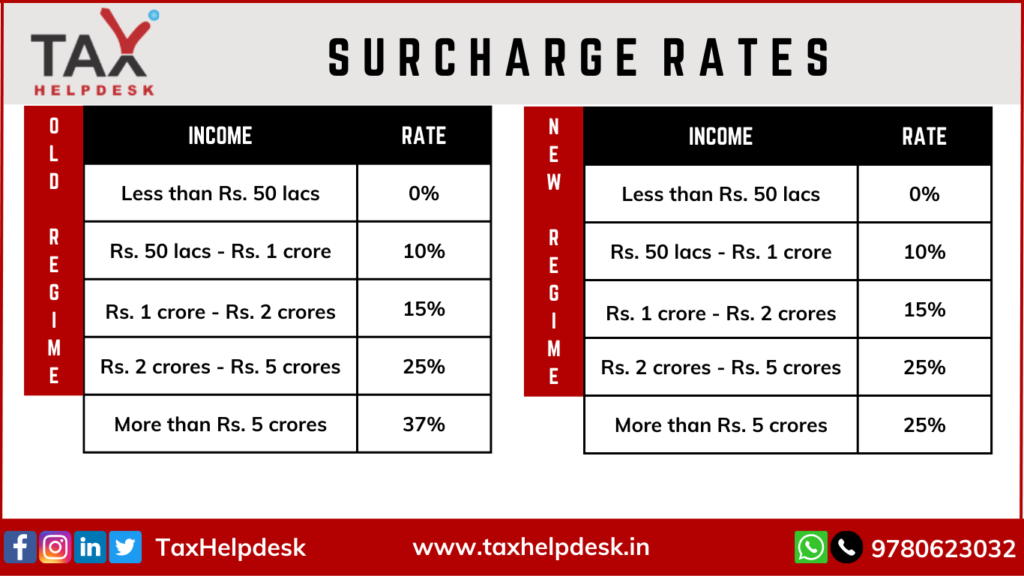
FAQs
Yes, the rebate under Section 87A is still available under both new and old tax regimes. However, the amount of rebate limit is not the same under these regimes. In the case of the new tax regime, if the person has a total income of Rs. 7 income, then he can claim a rebate of Rs. 25,000. On the other, if the person opts for the old tax regime and has a total income of Rs. 5 lacs, then he can claim a rebate of Rs. 12,500.
In case you are having income from salary, then you switch between the tax regimes during every financial year. However, if you also happen to have business income, then you have only once in a lifetime option to choose between the tax regimes.
Join TaxHelpdesk’s community via Whatsapp, Facebook, Instagram, LinkedIn, and X (Formerly Twitter).


